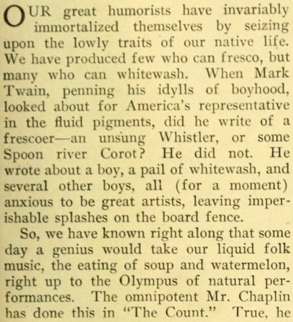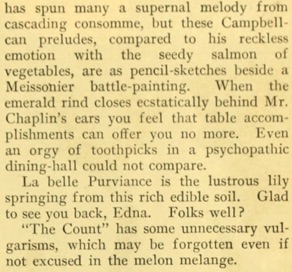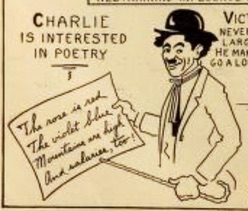The Count Clippings 33/50
Julian Johnson, Photoplay, New York, November 1916.
CHARLIE IS INTERESTED IN POETRY
Cartoon. The rose is red, The violet blue,
Mountains are high, And salaries, too!
(...) INTERESTING ITEMS about POPULAR PLAYERS,
Motion Picture, Feb. 1917
& „The Count“ (Mutual). – A typical Charlie Chaplin farce, with
the usual quota of slapsticks, chasing and pie-throwing,
plus a few original touches that bring this play up to his average,
but it is by no means his best. J.
(...) PHOTOPLAY REVIEWS, Motion Picture, Nov. 1916
„In the melon melange“
Editorial content. „The Shadow Stage
A Department of Photoplay Review
By Julian Johnson
OUR great humorists have invariably immortalized
themselves by seizing upon the lowly traits of our
native life. We have produced few who can fresco, but many
who can whitewash. When Mark Twain, penning his
idylls of boyhood, looked about for America‘s representative
in the fluid pigments, did he write of a frescoer –
an unsung Whistler, or some Spoon river Corot? He did not.
He wrote about a boy, a pail of whitewash, and several
other boys, all (for a moment) anxious to be great artists, leaving imperishable splashes on the board fence.
So, we have known right along that some day a genius
would take our liquid folk music, the eating of soup
and watermelon, right up to the Olympus of natural performances.
The omnipotent Mr. Chaplin has done this in The Count.
True, he has spun many a supernal melody from cascading
consomme, but these Campbell-can preludes,
compared to his reckless emotion, with the seedy salmon
of vegetables, are as pencil-sketches beside
a Meissonier battle-painting. When the emerald rind closes
ecstatically behind Mr. Chaplin‘s ears you feel that
table accomplishments can offer you no more. Even an orgy
of toothpicks in a psychopathic dining-hall could
not compare.
La belle Purviance is the lustrous lily springing from this rich
edible soil. Glad to see you back, Edna. Folks well?
The Count has some unnecessary vulgarisms, which may
be forgotten even if not excused in the melon melange.“
The Count is released
by Mutual September 4, 1916.
Redaktioneller Inhalt




